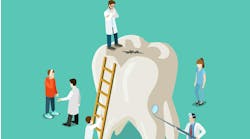Trending Upward, Though Results Are Mixed
Dentists reported mixed results for 2013. Practice production was up for 64.4% of respondents, yet high or extremely high stress was reported by 38.3% of doctors - breaking the record set in 2011.
These two key findings from the Dental Economics/Levin Group 2014 Annual Research Report indicate that, though many dentists were regaining their forward momentum financially in 2013, they were paying a greater personal price.
According to Dr. Roger P. Levin, chairman and CEO of Levin Group, "Viewed along with other metrics generated by our survey, these numbers tell us that more doctors have acknowledged the 'new normal' and begun making positive changes. Rather than waiting for conditions to improve, they are looking for ways to upgrade their management and marketing systems."
Levin adds, "Unfortunately, this takes a lot of time and effort, especially if they attempt to do it themselves. With personal assets and income to recoup - and the likelihood of lower-than-previous practice production and delayed retirement - many dentists are suffering from a great deal of stress. This finding also confirms what I've heard from many of the doctors whom I speak to in the 100 seminars I present each year."
About the Survey
This is the eighth edition of the Dental Economics/Levin Group Annual Research Report. Many more doctors took the time to complete the survey this year, indicating how highly they value this comprehensive report. By gathering and presenting meaningful data about the state of dentistry - and enabling individual practice owners to see where they fit in - the survey and report provide benchmarks and insights about how to achieve success in the new dental economy.
As in previous years, Levin Group designed the survey and collected responses, which were then tabulated and analyzed by the Levin Group Data Center/Data Analysis Division. This year, the survey posed questions in five areas:
1. Practice Overview
2. Practice Production
3. Collections and Billings
4. Procedure Mix
5. Doctor Satisfaction
The report represents a broad cross-section of U.S. general dentists - from solo practitioners to multidoctor practices, with offices in rural areas, small towns, suburbs, and large cities. In keeping with national statistics from other sources, approximately one-quarter of the respondents were female (26.8%). In addition, a greater proportion of doctors taking the survey were young doctors, especially in the 35-or-under bracket (up from 11.2% in 2013 to 14.5% this year).
Production Numbers
As mentioned earlier, total practice production was up for 64.4% of surveyed practices, and approximately the same percentage of respondents are expecting additional increases in 2014. This is considerably more optimistic than in any other year since the Great Recession in 2008. Although production was up for many dentists, 44% of them reported modest gains of 1% to 10%.
Looking at revenues per full-time doctor, there is a drop of 3.8%, from $649,839 to $625,278. Average production for full-time associates was $553,492. Average gross production per hygienist increased 9% compared with last year to $176,582, exemplifying what Dr. Levin refers to as "doing more with what you already have."
More Active Patients
The average number of new patients per month remained flat at 27 for the fourth year in a row. Yet, perhaps due to better patient retention, 57% of survey respondents reported an increase in the total number of patients in 2013.
"One of the business principles for growing in a down market is to do more with what you already have," repeats Dr. Levin. "For dental practices, this means increasing production on a per-patient basis. Today, the more successful GPs are conducting comprehensive exams and presenting more extensive treatment plans, including elective services. Their patients are made aware of all the services the practice can provide," he says. "This includes not only need-based, single-tooth treatment, but also larger, multitooth cases, as well as a wide range of cosmetic procedures and other elective options."
There is statistical evidence in the Dental Economics/Levin Group 2014 Annual Research Report indicating that dentists are moving in this direction, albeit slowly. In this year's report, elective treatment represented slightly more than 20% of total production - still lower than it should be, according to the consulting experts at Levin Group, but encouragingly higher than last year.
Working Harder, Working Longer?
The number of doctors reporting that they work full-time, defined as at least 3.5 days per week, reached 80% ... up significantly from 73% from the previous year. Surprisingly, 8% reported that they are working more than five days a week. These numbers may be related to the high levels of stress reported.
"In a sign that dentists recognize the true impact of the '8 Permanent Game Changers' I've been speaking about for several years now," says Dr. Levin, "they are becoming more realistic about their retirement. Almost half of the doctors who took our survey (49.3%) now believe they will have to postpone retirement." In last year's report, 59% of respondents believed they would be 61 or older before they would be able to retire. This year, that number has increased sharply, to 76%.
Conclusion
Overall, the Dental Economics/Levin Group 2014 Annual Research Report gives cause for cautious optimism. Though the market for dental services remains challenging, it seems to have stabilized and begun moving in the right direction again. Dentists realize they probably won't be able to retire as soon as they had once planned - undoubtedly contributing to their higher stress levels - but almost two-thirds of them believe this year will be better than last, and they are taking positive steps to make that happen.
We hope the report will help you gain new insights about the current state of dentistry, where you and your practice stand, and how you can align your growth strategies with the changing rules in the new dental economy.
We'd like to thank all the dentists who participated in our survey. Your voice has been heard, and we look forward to hearing from you again in 2015. You can view the complete survey results at www.levingroup.com or www.dentistryiq.com.
Good News: Collections Are Up Again
As you may recall, we reported a drop in 2012 collections, to a seven-year low of 91.3%. This number rebounded for 2013, with dentists reporting they were able to collect 94.2% of their fees. Though still substantially below the Levin Group target of 99%, this collection rate is nevertheless a sign that dentists are becoming more businesslike in their approach to financial matters. The improved collection rate can be explained, in part, by the fact - borne out in the report - that practices have been shifting away from riskier "in-house" financing of treatment to alternatives such as credit cards and outside patient financing by providers such as CareCredit.
This focus on improving business systems has a direct impact on doctor income. For example, using the average production numbers reported this year, increasing collections from 94.2% to the 99% Levin Group target would result in an additional $32,500 of income per doctor.





